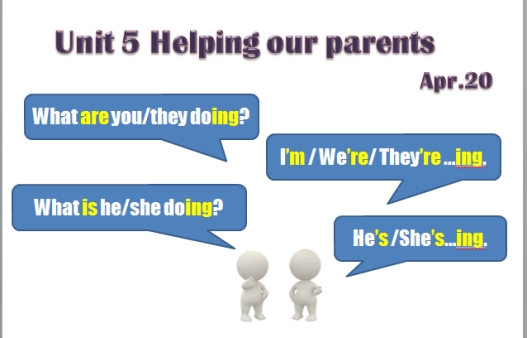
Unit 5 Helping our parents
Grammar time
![]()
Teaching contents 教学内容
Grammar time
Teaching aims and learning objectives 教学目标
知识目标:
1. 能理解并掌握家务类短语:make the bed, wash clothes。
2. 能根据动名词的发音、拼写规则推测出现在分词的发音、拼写规则。
3. 能简单归纳现在进行时的语法结构be + doing。
4. 能理解并掌握现在进行时的特殊疑问句及答句。
What are you/they doing? I am + doing. We/ They are + doing.
What is he/she doing? He/She is + doing.
能力目标:
1. 能进一步理解Story time课文,并根据关键词进行流利复述。
2. 能运用be + doing进行问答和表述。
3. 通过相关练习,对所学知识进行听、说、读、写能力的训练与巩固。
情感目标:
通过“帮助父母”话题的谈论,培养作为家庭成员要承担家庭责任的意识。
Focus of the lesson and predicted area of difficulty 教学重点和难点
教学重点:
1. 能理解并掌握家务类短语:make the bed, wash clothes。
2. 能掌握现在分词v-ing的发音、拼写规则。
3. 能理解现在进行时语法结构be + doing,并会用特殊疑问句进行问答和表述。
教学难点:
1. 理解现在进行时使用的场景。
2. 能运用be + doing结构进行准确的问答和表述,尤其是做到不遗漏be动词。
Teaching procedures 教学过程
Step 1 Warm-up
1. Greeting
2. Learning aims
T: This lesson, we’ll learn Grammar time in Unit 2. Here’re the learning aims.
【设计意图:揭示本课学习目标,带着明确的目的进行学习,可提高学习效率。】
Step 2 Revision time
1. Read the story
T: Now, let’s read Story time. And each group can choose one way to read. Understand? Go!
【设计意图:复习Story time主要内容,通过自主选择的朗读方式对课文内容进一步深化,为下面的问答和复述环节做准备。】
2. Fill in the forms
T: I think you have finished these forms at home, right? So what is Mike’s father doing?
S1: Mike’s father is cleaning the car in the morning.
(同法引导学生口头完成表格其他部分填空)
T: Is he right? Yes. So from this form, we know in the morning, Mike’s father is …
(引导学生根据表格复述课文)
【设计意图:1. 充分利用文本资源——表格,并以口头问答检测家庭作业的方式,回顾课文人物主要活动。2. 在问答中,从师生过渡到生生的问答方式,不断操练现在进行时特殊疑问句及答句,为学生归纳总结语法现象做好铺垫。】
3. Match and say
T: Is Tim helping his parents? Who is helping parents?
S: Helen and Mike.
T: What are they doing? Let’s match and say. You can say like this, “Helen is …”
(学生连线并回答)
T: Great. So from these pictures we know in the morning, Helen is …
They are helping parents do housework.
【设计意图:1. 再次巩固操练现在进行时的表述。2. 充分利用文本资源——匹配图片,突出主人公帮助父母主要活动,为过渡到家务劳动词汇学习做好准备。】
Step 3 Learning time
1. Look and learn
T: Do they often do housework? Yes, look, this is Sunday morning, Helen and Mike are helping their parents do housework again. What are they doing?
(引导学生回答并新授词汇make the bed, wash clothes, water flowers, walk the dog)
T: Now, we know Helen and Mike can do so much housework. They can …
(引导学生将所学家务类词组朗读一遍)
【设计意图:1. 通过延续情境新授两个家务类短语。2. 由于短语中无生词,采用四选一的方式让学生图文匹配学习新词汇,并拓展词汇。3. 小结所有所学家务类短语。】
2. Act and guess
T: I can do these kinds of housework, too. Now, please watch and guess. What am I doing? You can answer me like this, “You are + doing.” Clear? Go!
T: What am I doing? (做洗衣服动作)
S: You’re washing clothes.
(同法,做其他五个家务类动作)
【设计意图:1. 通过教师做动作学生猜巩固家务类短语。2. 通过第一人称的特殊疑问句问答,调节课堂气氛的同时,继续操练巩固现在进行时句型。】
3. Say a chant
T: Good job. Can you do these kinds of housework? Great, let’s say a chant about housework. At first, let me show you. (教师展示)
T: Now, it’s your turn. (学生展示)
T: Boys and girls, what are you doing?
S: We are helping parents do housework. (引导学生说出)
T: Great. So all of you are good children.
【设计意图:1. 通过表演chant来巩固家务类短语现在分词的发音。2. 通过chant活跃气氛的同时,引出what are you doing?句型。3.进行情感教育,使学生明白承担力所能及的家务是家庭成员的责任。】
Step 4 Grammar time
1. Think and say
T: Just now, I asked you a lot of questions, such as: What are you doing?
What can you find out from these questions?
S: (引导学生说出) They all have Be-verbs, doing.
T: When we see “be + doing”, it means “已经发生” “经常发生” “将要发生” or “正在发生”?
S: “正在发生”.
T: Yes.
(讲解“be + doing”的结构用于现在进行时,这里表示正在进行的动作)
【设计意图:1. 引导学生通过观察,归纳出现在进行时的句型结构。2. 教师强调现在进行时所表达的含义。】
2. Read and complete
T: Now please answer those questions? Don’t forget “be + doing”.
(引导学生填空)
T: Great! And how to read these “doing”?
Here’s a tips. (当动词词尾是辅音时,需要和ing连读)
For example, sweeping, …
T: Now, let’s read these sentences again.
【设计意图:1. 充分利用文本资源进行填空练习,巩固be + doing语法点。2.强调现在分词-ing词尾发音规则。】
3. Read and say
T: Look, these words all add “ing” directly, and there are some words need to take “e” away. Some need double letter. When we learn “like + doing”, we have talked about that, do you remember? Try to say!
(引导学生分类举例)
【设计意图:引导学生根据动名词的拼写规则,归纳现在分词的拼写规则。】
Step 5 Consolidation
1. Play and say
(1) Give examples
T: So do you understand how to use “be + doing”? Great, let’s play a game about it.
For example, when you see “you”, “play football”, “in the playground”, what can you say?
(示范造句)
(2) Explain the rules
T: Great, now let’s play the game. But how to play? (讲解规则)
(3) Play and say
T: Boys and girls, are you ready? Go!
Who? (Uncle Bob) What? (cook dinner) Where? (in front of the school)
S: Uncle Bob is cooking dinner in front of the school.
T: Oh, so funny. Let’s go on!
(同法开展其他三轮造句比赛)
【设计意图:采用男女生、教师三方提供不同关键词快速造句的活动,增加操练句型的趣味性。】
2. Listen and write
T: Now it’s time to care about my friends. What are they doing? Let me click the “Wechat”. (点击课件播放语音)
T: So what are my friends doing now? Let’s listen again and complete the blanks.
(再次播放音频)
S: Coco is … (校对答案)
【设计意图:通过听微信群聊消息的方式进行听力练习,一方面提升了听力练习的趣味性,一方面进行了听写的训练。】
Homework 家庭作业
1. Continue to play the game “Who is the best?” with your friends.
2. Sing the song Polly, put the kettle on after the tape.
Teaching aids 教学准备(含板书设计)
教学准备:1. 教师准备:光盘、ppt、板书、相关道具
2. 学生准备:熟读Story time
板书设计:

说课
本课为Unit 5 Helping our parents的第二课时,教学内容为Grammar time板块,主要讲述现在进行时特殊疑问句及答句be + doing的句型结构。在教学中需要引导学生根据动名词的学习经验来归类现在分词的发音、拼写规则。
为了让学生理解现在进行时的语用环境,本课先从复习课文入手,充分利用文本资源,通过Fill in the forms和Match and say理清文章脉络,同时不断操练现在进行时的问答和表述。由Helen和Mike帮做家务的话题,过渡到学习家务类新短语,并通过Watch and guess和Say a chant的形式,使学生聚焦现在分词doing的发音规则,并进一步帮助学生巩固了现在进行时特殊疑问句问答句型。在大量的句型训练基础上,让学生通过观察、比较,自然找出现在进行时的语法结构、使用情境、现在分词拼写规则。最后的操练巩固环节,采用Play and say富有趣味性、竞争性的活动扎实的巩固了本课所学,还通过Listen and write这个符合时代气息的活动,训练了学生的听写技能,使学生能学以致用。